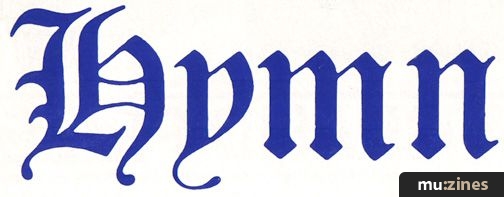Magazine Archive
Home -> Magazines -> Issues -> Articles in this issue -> View
Hymn | |
UltravoxArticle from Electronics & Music Maker, January 1983 | |
'Hymn' music to play — we've linked the music to an exclusive interview with Midge Ure and Billy Currie on E&MM cassette, discussing and playing the instruments for this new Ultravox single

From their 'QUARTET' LP Chrysalis CDL 1394
An Electro-Music Transcription by Mike Beecher
About the LP 'Quartet'
ULTRAVOX
(Vocals, Synths, Guitar)
Billy Currie
(Keyboards & Violin)
Chris Cross
(Synth/Gtr Bass)
Warren Cann
(Acoustic & Electronic Percussion)
Unlike 'Vienna', which was done very quickly, this latest LP was done step by step, like 'Rage in Eden', which took three months with some twelve hours every day on it. The rest of the tracks were also done over quite a long period until completed. Most of the material was recorded at Air Studios and then finished at Montserrat in the Caribbean with George Martin doing the mixing and overdubs.
'Reap the Wild Wind' was the most percussive song from the LP with Warren using a lot of Simmons SDSV modules. The bass line (as on 'Serenade' and several other tracks) is the group's own pre-recorded bass guitar sound in the Emulator. The PPG Wave 2.2 synthesiser made the main sounds for the piece, which was released as a single.
The Hymn

"We put this on a different level from the sleigh bells, jingling kind of piece for Christmas", says Warren. "The song just gave us the feeling for the season as a sort of anthem. There's a guitar solo from Midge in the middle section and quite a lot of backward tape sounds — voices in particular."
"A portion of the song is from one of the first tunes we wrote with Midge in the band some three years ago. 'The Hymn' starts with a vocal intro accompanied by a throaty vocoder-type PPG preset mixed with multi-tracked vocals — sounding like a choir. The chorus section main theme is done by Billy on the CS80 (with the ribbon controller — a trade mark of ours!). Midge uses a lot of open strum guitar done with a capo to keep the strings ringing."
"There's a bass counter melody in the verses on the PPG", adds Midge, "and the triggered strings is from the Emulator (with a Synclavier 'strings' sample we've done). The solo was done on Bill's ARP using the flanger with a Marshall Time Modulator and second oscillator switching octaves to give it our special sound for Ultravox. The vocal line was quite a challenge for me especially as the key changes up and it took a long time to get right at Montserrat — think Russian male voice choir and you've got it!"
"I've stopped using the Yamaha CS50 and CS40M because by the time they're stacked up you couldn't see me above the keyboard! I've kept Yamaha's SS30 string machine though which I think is great — I don't think we've ever played anything without it. The main synth is now the PPG Wave 2.2 which is very versatile. I like its stereo output which widens the whole sound on stage, although it probably doesn't affect out front too much. The detuning facility adjustable on every sound is useful and so are the 99 memories. In 'The Hymn' I used a Cymbalom type of sound with it, as well as some really good percussive effects. In 'Visions in Blue' I play the bass in stereo on the PPG while I'm singing the vocals — we're using Electro-Voice and Shure mics at the moment. My 'vocal rack' gives me total control for singing by using footswitching at the front mic position on stage and also at the keyboards. I can switch in echo, bizarre EQs, flanger/doubler (more as a doubler), AMS Digital Delay and Yamaha E1010 Analogue Delay. I don't know of other vocalists who control their own sound on stage — maybe I'm the only one! Peter Woods, our electronic engineer, put the rack together for me."
"I'm using an early version of the ARP Odyssey synth plus the Yamaha string synth for a nice phased chorus 'cello sound," says Billy.
I also like the Elka Rhapsody strings for a colder feeling. The Yamaha Electric Grand uses an MXR Flanger to fill it out a bit and also a Boss Chorus. Then the Yamaha GS1 has the strings for 'Visions in Blue', for example, (I've been to Hamburg with Dave Bristow to work on new sounds for the instrument such as a bell sound I wanted). The CS80 plays 'The Hymn' theme using its string presets — very loud! And the Emulator gives flute sounds whilst my newest addition for soloing is the PPG — but we don't use its sequencer. We trigger the last two from Warren's main trigger unit, (incidentally designed by Peter Kershaw, E&MM micro consultant)."
"My violin has a process unit that added transposed pitches of octave, third, fourth below and fifth above, with a compressor to keep the sound at an even output level — important for violins since its upper notes get weaker."
Finally Chris comments on his line-up: "I use Minimoog and PPG Wave 2.2 for bass and harmony lines with MXR flanger/doubler in my own rack amongst other things, plus Martin side fills that are popular these days. We've several Yamaha scope tuners (PT-4) for checking out pitches and my guitars are Yamaha's new active guitar plus an Ibanez Roadstar."
Warren will be discussing his percussion equipment in one of his forthcoming drum column pages.
The group have had a completely new stage set made for their current tour — everything is light grey, including keyboards, guitars, PA, drums, Billy's violin right down to a grey carpet and all fittings! The large futuristic 'building' that forms the background and sides has windows for spots and lighting crew. Smoke billows out from hidden pipes, and even cables have been concealed to present a 'smooth' clean appearance. The light show bounces off the grey to give plenty of colour.
Ultravox are currently doing a series of tours covering Ireland and the UK. They've also a German TV show where they're doing two songs using a 70 piece orchestra and large choir which is a new experiment for the group. Then they're off to Scandinavia, through Europe, followed by a short break before covering Canada, the American East and West Coast, Japan, New Zealand and Australia.
Hymn - Ultravox
Use these parts as a guide for drums: The bar marked A is repeated throughout music section A, the bars marked B are for all section B, etc. Where important beats are added, these are indicated on the score on a drum line.
RECORDED ON CHRYSALIS "Quartet" (CDL 1394) and now released as a single.

(Click image for higher resolution version)

(Click image for higher resolution version)

(Click image for higher resolution version)

(Click image for higher resolution version)
Reproduced by permission of Ultravox © Arrangement copyright Mike Beecher 1983.
More with this artist
Ultravox (Ultravox) |
Ultravox On Air (Ultravox) |
Love's Great Adventure (Ultravox) |
Re-Vox (Ultravox) |
More from related artists
Ronny's Electro-Music Cabaret (Warren Cann) |
In The Garden (John Foxx) |
John Foxx (John Foxx) |
From 24 tracks to 8 (John Foxx) |
Midge Ure - A Man With A Gift (Midge Ure) |
Days of Ure (Midge Ure) |
John Foxx: Recording In Mysterious Ways (John Foxx) |
Ultraboxes (Midge Ure) |
Life After Ultravox (Billy Currie) |
Publisher: Electronics & Music Maker - Music Maker Publications (UK), Future Publishing.
The current copyright owner/s of this content may differ from the originally published copyright notice.
More details on copyright ownership...
Interview by Mike Beecher
Help Support The Things You Love
mu:zines is the result of thousands of hours of effort, and will require many thousands more going forward to reach our goals of getting all this content online.
If you value this resource, you can support this project - it really helps!
Donations for April 2024
Issues donated this month: 0
New issues that have been donated or scanned for us this month.
Funds donated this month: £7.00
All donations and support are gratefully appreciated - thank you.
Magazines Needed - Can You Help?
Do you have any of these magazine issues?
If so, and you can donate, lend or scan them to help complete our archive, please get in touch via the Contribute page - thanks!























